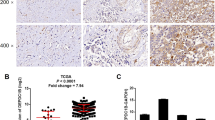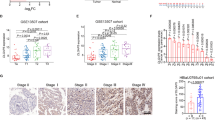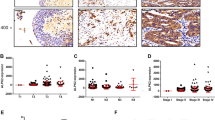Abstract
In an attempt to disclose mechanisms of bladder carcinogenesis and discover novel target molecules for development of treatment, we applied a cDNA microarray to screen genes that were significantly transactivated in bladder cancer cells. Among the upregulated genes, we here focused on a novel gene, (DEPDC1) DEP domain containing 1, whose overexpression was confirmed by northern blot and immunohistochemical analyses. Immunocytochemical staining analysis detected strong staining of endogenous DEPDC1 protein in the nucleus of bladder cancer cells. Since DEPDC1 expression was hardly detectable in any of 24 normal human tissues we examined except the testis, we considered this gene-product to be a novel cancer/testis antigen. Suppression of DEPDC1 expression with small-interfering RNA significantly inhibited growth of bladder cancer cells. Taken together, these findings suggest that DEPDC1 might play an essential role in the growth of bladder cancer cells, and would be a promising molecular-target for novel therapeutic drugs or cancer peptide-vaccine to bladder cancers.
This is a preview of subscription content, access via your institution
Access options
Subscribe to this journal
Receive 50 print issues and online access
$259.00 per year
only $5.18 per issue
Buy this article
- Purchase on Springer Link
- Instant access to full article PDF
Prices may be subject to local taxes which are calculated during checkout




Similar content being viewed by others
References
Anazawa Y, Nakagawa H, Furihata M, Ashida S, Yoshioka H, Shuin T et al. (2005). Analysis of gene-expression profiles after gamma irradiation of normal human fibroblasts. PCOTH, a novel gene overexpressed in prostate cancers, promotes prostate cancer cell growth through phosphorylation of oncoprotein TAF-Ibeta/SET. Cancer Res 65: 4578–4586.
Ardavanis A, Tryfonopoulos D, Alexopoulos A, Kandylis C, Lainakis G, Rigatos G . (2005). Gemcitabine and docetaxel as first-line treatment for advanced urothelial carcinoma: a phase II study. Br J Cancer 92: 645–650.
Ashida S, Furihata M, Katagiri T, Tamura K, Anazawa Y, Yoshioka H et al. (2005). Expression of novel molecules, MICAL2-PV (MICAL2 prostate cancer variants), increases with high Gleason score and prostate cancer progression. Clin Cancer Res 12: 2767–2773.
Boutros M, Paricio N, Strutt DI, Mlodzik M . (1998). Dishevelled activates JNK and discriminates between JNK pathways in planar polarity and wingless signaling. Cell 94: 109–118.
Hamamoto R, Furukawa Y, Morita M, Iimura Y, Silva FP, Li M et al. (2004). SMYD3 encodes a histone methyltransferase involved in the proliferation of cancer cells. Nat Cell Biol 6: 731–740.
Kharrat A, Millevoi S, Baraldi E, Ponting CP, Bork P, Pastore A . (1998). Conformational stability studies of the pleckstrin DEP domain: definition of the domain boundaries. Biochim Biophys Acta 1385: 157–164.
Lehmann J, Retz M, Stockle M . (2002). Chemotherapy in the post-MVAC era: the case for adjuvant chemotherapy. World J Urol 20: 144–150.
Li L, Yuan H, Xie W, Mao J, Caruso AM, McMahon A et al. (1999). Dishevelled proteins lead to two signaling pathways. Regulation of LEF-1 and c-Jun N-terminal kinase in mammalian cells. J Biol Chem 274: 129–134.
Martemyanov KA, Lishko PV, Calero N, Keresztes G, Sokolov M, Strissel KJ et al. (2003). The DEP domain determines subcellular targeting of the GTPase activating protein RGS9 in vivo. J Neurosci 23: 10175–10181.
Nagayama S, Fukukawa C, Katagiri T, Okamoto T, Aoyama T, Oyaizu N et al. (2005). Therapeutic potential of antibodies against FZD10, a cell-surface protein, for synovial sarcomas. Oncogene 24: 6201–6212.
Nagayama S, Iiizumi M, Katagiri T, Toguchida J, Nakamura Y . (2004). Identification of PDZK4, a novel human gene with PDZ domains, that is upregulated in synovial sarcomas. Oncogene 23: 5551–5557.
Park JH, Lin ML, Nishidate T, Nakamura Y, Katagiri T . (2006). PDZ-binding kinase/T-LAK cell-originated protein kinase, a putative cancer/testis antigen with an oncogenic activity in breast cancer. Cancer Res 66: 9186–9195.
Parkin DM, Bray F, Ferlay J, Pisani P . (2005). Global cancer statistics, 2002. CA Cancer J Clin 55: 74–108.
Petricoin III EF, Hackett JL, Lesko LJ, Puri RK, Gutman SI, Chumakov K et al. (2002). Medical applications of microarray technologies: a regulatory science perspective. Nat Genet 32 (Suppl 32): 474–479.
Ponting CP, Bork P . (1996). Pleckstrin's repeat performance: a novel domain in G-protein signaling? Trends Biochem Sci 21: 245–246.
Rosenberg JE, Carroll PR, Small EJ . (2005). Update on chemotherapy for advanced bladder cancer. J Urology 174: 14–20.
Saito-Hisaminato A, Katagiri T, Kakiuchi S, Nakamura T, Tsunoda T, Nakamura Y . (2002). Genome-wide profiling of gene expression in 29 normal human tissues with a cDNA microarray. DNA Res 9: 35–45.
Shimo A, Nishidate T, Ohta T, Fukuda M, Nakamura Y, Katagiri T . (2007). Elevated expression of PRC1, protein regulator of cytokinesis 1, involved in the growth of breast cancer cells. Cancer Sci 98: 174–181.
Shimokawa T, Furukawa Y, Sakai M, Li M, Miwa N, Lin YM et al. (2003). Involvement of the FGF18 gene in colorectal carcinogenesis, as a novel downstream target of the h-catenin/T-cell factor complex. Cancer Res 63: 6116–6120.
Sternberg CN . (1995). The treatment of advanced bladder cancer. Ann Oncol 6: 113–126.
Takata R, Katagiri T, Kanehira M, Tsunoda T, Shuin T, Miki T et al. (2005). Predicting response to methotrexate, vinblastine, doxorubicin, and cisplatin neoadjuvant chemotherapy for bladder cancers through genome-wide gene expression profiling. Clin Cancer Res 11: 2625–2636.
Taniuchi K, Nakagawa H, Hosokawa M, Nakamura T, Eguchi H, Ohigashi H et al. (2005b). Overexpressed P-cadherin/CDH3 promotes motility of pancreatic cancer cells by interacting with p120ctn and activating rho-family GTPases K. Cancer Res 65: 3092–3099.
Taniuchi K, Nakagawa H, Nakamura T, Eguchi H, Ohigashi H, Ishikawa O et al. (2005a). Down-regulation of RAB6KIFL/KIF20A, a kinesin involved with membrane trafficking of discs large homologue 5, can attenuate growth of pancreatic cancer cell. Cancer Res 65: 105–112.
Theodore C, Geoffrois L, Vermorken JB, Caponigro F, Fiedler W, Chollet P et al. (2005). Multicentre EORTC study 16997: feasibility and phase II trial of farnesyl transferase inhibitor & gemcitabine combination in salvage treatment of advanced urothelial tract cancers. Eur J Cancer 41: 1150–1157.
Togashi A, Katagiri T, Ashida S, Fujioka T, Maruyama O, Wakumoto Y et al. (2005). Hypoxia-inducible protein 2 (HIG2), a novel diagnostic marker for renal cell carcinoma and potential target for molecular therapy. Cancer Res 65: 4817–4826.
Vaughn DJ . (1999). Review and outlook for the role of paclitaxel in urothelial carcinoma. Semin Oncol 26 (1 Suppl 2): 117–122.
Acknowledgements
We thank Ms Yoshiko Fujisawa and Ms Kie Naito, for grateful technical supports and Dr Yataro Daigo for preparation of lung tissues and Dr Shingo Ashida of Department of Urology, Kochi Medical School and Dr Wataru Obara of Department of Urology, Iwate Medical University for preparation of bladder cancer tissues sections, and Dr Akira Togashi for helpful discussion.
Author information
Authors and Affiliations
Corresponding author
Additional information
Supplementary Information accompanies the paper on the Oncogene website (http://www.nature.com/onc).
Supplementary information
Rights and permissions
About this article
Cite this article
Kanehira, M., Harada, Y., Takata, R. et al. Involvement of upregulation of DEPDC1 (DEP domain containing 1) in bladder carcinogenesis. Oncogene 26, 6448–6455 (2007). https://doi.org/10.1038/sj.onc.1210466
Received:
Revised:
Accepted:
Published:
Issue Date:
DOI: https://doi.org/10.1038/sj.onc.1210466
Keywords
This article is cited by
-
DEPDC1 and KIF4A synergistically inhibit the malignant biological behavior of osteosarcoma cells through Hippo signaling pathway
Journal of Orthopaedic Surgery and Research (2023)
-
Current progress in the development of prophylactic and therapeutic vaccines
Science China Life Sciences (2023)
-
Silencing eL31 suppresses the progression of colorectal cancer via targeting DEPDC1
Journal of Translational Medicine (2022)
-
Linc-ROR facilitates progression and angiogenesis of hepatocellular carcinoma by modulating DEPDC1 expression
Cell Death & Disease (2021)
-
A phase I/Ib study of OTSGC-A24 combined peptide vaccine in advanced gastric cancer
BMC Cancer (2018)



